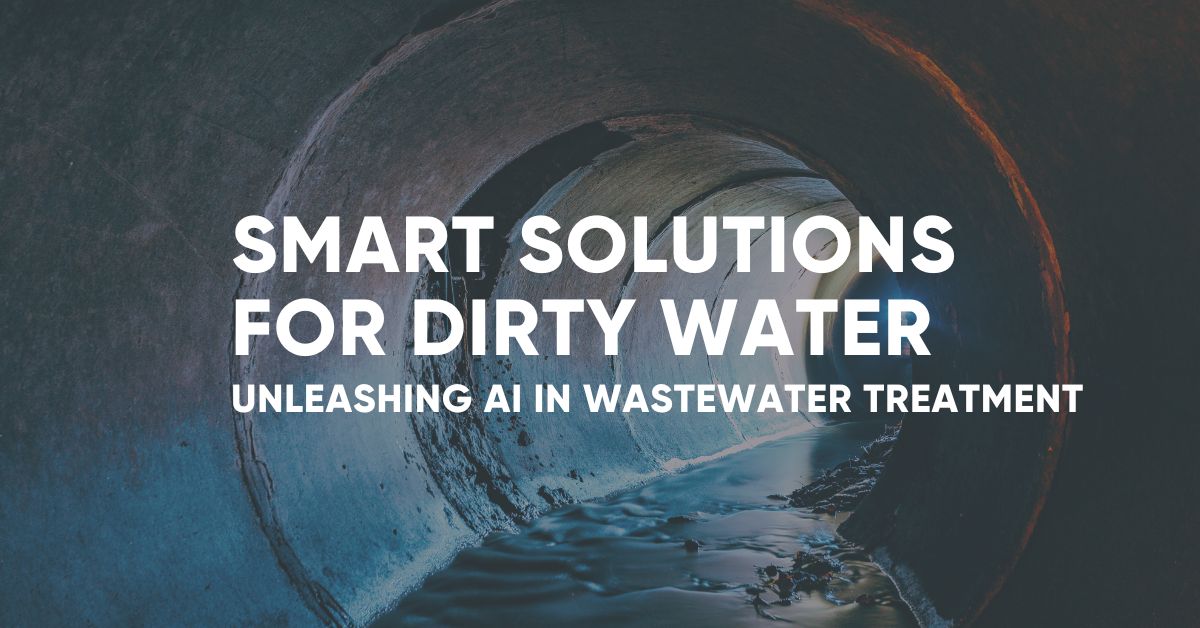Wastewater Management as a sector may not be the most glamorous of industries, but it is one that plays an indispensable role in maintaining our cities’ cleanliness, safeguarding our environment, and supporting community health. As our infrastructure ages and crumbles, maintaining our key structures with traditional methods is getting untenable.
To improve the wastewater ecosystem and avoid system failures, municipalities are looking to Artificial Intelligence (AI) for operational improvements and inspection & data analysis. AI is revolutionizing wastewater management, addressing operational challenges, mitigating risks, and helping to save both money and the planet in the process.
Let’s look at how AI is impacting both wastewater treatment centers and wastewater pipeline analysis.
Navigating the Complex Realm of Wastewater
Before we dive into the remarkable AI solutions, it’s essential to understand the challenges inherent in wastewater management. This intricate process involves the treatment of wastewater laden with a diverse range of contaminants, including organic matter and chemicals, where any misstep in the treatment process can have grave environmental consequences.
Overcoming Operational Challenges
- Variable Loads: Wastewater treatment plants must contend with fluctuating inflow rates, particularly during heavy rains or periods of peak usage, which can place significant strain on the system.
- Aging Infrastructure: Many wastewater treatment facilities across the globe are operating with antiquated equipment, desperately needing upgrades. These dated plants often prove inefficient, posing considerable maintenance costs.
- Environmental Implications: The improper discharge of untreated or inadequately treated wastewater can spell ecological disaster, jeopardizing aquatic ecosystems and their inhabitants. Over 850 billion gallons of untreated wastewater and stormwater are illegally discharged per year!
AI Solutions to Operational Challenges
- Predictive Maintenance: AI is adept at monitoring the condition of equipment and predicting when maintenance is due. This foresight minimizes costly downtimes and emergency repairs, saving substantial amounts on replacement parts and labor expenses.
- Optimizing Treatment Processes: AI analyzes data collected from sensors throughout the treatment process, facilitating the optimization of chemical dosing, energy consumption, and overall system efficiency. This not only translates into monetary savings but also lessens the environmental footprint.
- Real-time Monitoring and Alerts: AI offers the capability to continuously monitor wastewater quality, detect anomalies, and promptly alert operators to potential issues. This early warning system averts contamination and ensures compliance with stringent environmental regulations.
- Data-Driven Decision Making: By processing vast volumes of data and providing actionable insights, AI empowers plant operators to make informed decisions. This translates into timely adjustments to treatment processes, cost reductions, and heightened treatment efficiency.
Mitigating Risks and Realizing Savings
How does AI precisely mitigate risks and translate into monetary savings in wastewater management?
- Reduced Energy Consumption: AI-driven optimization of treatment processes significantly curtails energy consumption. This not only lowers operational costs but also lessens the carbon footprint associated with wastewater treatment.
- Enhanced Environmental Compliance: AI ensures that wastewater treatment plants consistently meet environmental regulations, mitigating the risk of fines and penalties for non-compliance.
- Extended Equipment Lifespan: Predictive maintenance by AI prolongs the lifespan of equipment, diminishing the need for expensive replacements.
- Early Issue Detection: AI’s real-time alerts prevent costly emergencies and environmental damage by enabling swift corrective actions.
- Removing Bias and Improving Quality: Human inspectors get tired, AI does not. AI can identify potential safety and quality risks 24 hours a day with the same accuracy rates.
Enhancing Wastewater Pipeline Inspections with AI
In addition to its transformative impact on wastewater treatment processes, AI offers a powerful solution for optimizing wastewater pipeline inspections. This critical aspect of wastewater management often involves manual labor and traditional inspection methods that are time-consuming, costly, and can sometimes miss potential issues. AI brings a new level of efficiency and accuracy to this aspect of the industry.
Challenges in Pipeline Inspections
- Vast Network: Wastewater systems encompass extensive networks of pipelines that crisscross cities and regions. Inspecting these pipelines manually can be a logistical nightmare.
- Aging Infrastructure: Just like treatment plants, many wastewater pipelines are aging and prone to degradation, leading to leaks, blockages, or structural issues.
AI-Driven Pipeline Inspection Solutions
- Drones and AI: Drones equipped with cameras and AI algorithms can fly over pipelines, capturing high-resolution images and videos. AI can then analyze this visual data to identify potential issues, such as cracks, corrosion, or blockages.
Watch the drone inspection performed by ClearObject with the City of Fishers, Indiana.
- Sensors and IoT: IoT devices and sensors can be deployed within pipelines to monitor conditions in real time, or drones can be equipped with MSI arrays. AI processes the data generated by these sensors to detect anomalies, like changes in pressure or flow rates, which may indicate a problem.
- Predictive Analytics: AI can use historical data, such as maintenance records and inspection reports, to predict when and where pipeline issues are likely to occur. This proactive approach allows for targeted inspections and maintenance, reducing costs and minimizing disruptions.
Benefits of AI in Pipeline Inspections
- Cost Savings: AI-driven inspections eliminate the need for extensive human labor and allow for quicker identification of issues, think hours, not months. This results in substantial cost savings over time.
- Improved Accuracy: AI algorithms can detect subtle signs of pipeline degradation that may go unnoticed by the human eye. This accuracy reduces the risk of pipeline failures and environmental contamination.
- Reduced Downtime: By identifying issues in real-time or predicting them before they become critical, AI minimizes pipeline downtime and service disruptions, benefiting both the environment and the public.
- Extended Pipeline Lifespan: Timely repairs and maintenance, guided by AI insights, extend the lifespan of wastewater pipelines, reducing the need for costly replacements.
AI’s application in wastewater pipeline inspections represents a significant leap forward in ensuring the reliability and efficiency of our wastewater infrastructure. By leveraging AI-powered technologies such as drones, sensors, and predictive analytics, we can mitigate risks, reduce costs, and contribute to the overall sustainability of wastewater management. It’s another remarkable example of how AI is not just a buzzword but a genuine force for positive change in our world.
A Promising, Sustainable Tomorrow
Wastewater treatment is an essential component of our quest for a cleaner, more sustainable future. Every time you turn on the tap or flush the toilet, remember that AI algorithms are quietly toiling behind the scenes to ensure that our wastewater is treated responsibly, ultimately benefiting our environment and generations to come. Here’s to a greener, cleaner tomorrow!

